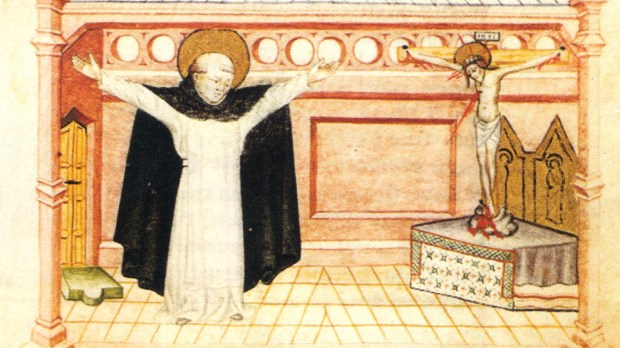On August 6, the Dominican Order around the world is kicking off a year-long celebration marking the 800th anniversary of the death of St. Dominic. The holy founder died on August 6, 1221, at age 51. Today, August 6 is celebrated in the universal Church as the Feast of the Transfiguration; St. Dominic’s feast is celebrated two days later on August 8.
The Dominicans have chosen a unique image to guide the jubilee: a painting that is nearly 20 feet wide and 16 inches tall, depicting St. Dominic around the table with his brothers.
As Fr. Gerard Francisco Parco Timoner, current Master General of the order, explained to Vatican News, the so-called Mascarella table (named for where it is kept in the Bolognese Church of Santa Maria della Mascarella) celebrates Dominic “not as a saint alone on a pedestal,” but St. Dominic “with his community, with his brothers.”
For the jubilee, the various parts of the painting, usually kept in separate places, will be brought together for the first time.
The table is notable not only for its symbolic presentation of community, but also because the depiction of Dominic, in the center with a halo, is the first portrait of St. Dominic painted shortly after his canonization, which occurred in the year 1234, not quite 13 years after the saint’s death.
Jubilee
St. Dominic’s itinerant preaching culminated in Bologna where his mortal remains are kept and venerated, thus Bologna is the center of the jubilee.
A beautiful tradition is associated with the transfer of the mortal remains of Dominic, which were moved a year before his canonization, so that they would be in a more prominent spot in the church.
While the friars were bracing for the smell that would accompany the exhumation, instead a beautiful fragrance emanated from the tomb.
“Its sweetness astonished those present, and they were filled with wonder at this strange occurrence,” wrote Blessed Jordan of Saxony, one of the first leaders of the Dominicans.
“The body was carried to the marble sepulcher where it would rest – it and the perfume that it poured forth. This marvelous aroma which the holy body emitted was evidence to all how much the saint had truly been the good odor of Christ,” he wrote (cf 2 Corinthians 2:15: For we are the aroma of Christ to God among those who are being saved and among those who are perishing.)
Dominic today
In May, Pope Francis wrote the Dominicans to mark this jubilee year. The Holy Father’s letter emphasizes a handful of the key elements that Dominic has given the Church.
- Unity of truth and love
As a student in Palencia, he came to appreciate the inseparability of faith and charity, truth and love, integrity and compassion. As Blessed Jordan of Saxony tells us, touched by the great numbers who were suffering and dying during a severe famine, Dominic sold his precious books and, with exemplary kindness established a center for almsgiving where the poor could be fed (Libellus, 10).
The Holy Father noted certain Friars who exemplified this union of truth and charity:
- The work of Friar Francisco de Vitoria, who proposed a framework of international law grounded in universal human rights.
- This in turn provided the philosophical and theological foundation for the heroic efforts of Friars Antonio Montesinos and Bartolomé de Las Casas in the Americas, and Domingo de Salazar in Asia to defend the dignity and rights of the native peoples.
2. Importance of life in common
Dominic simply wanted to be called Brother Dominic, forgoing a title indicating his governance of the order.
“This ideal of fraternity was to find expression in an inclusive form of governance, in which all shared in the process of discernment and decision-making,” the Holy Father noted.
3. A charism in all states of life
The Dominican charism of preaching … found eloquent expression in the writings of Saint Catherine of Siena, the paintings of Blessed Fra Angelico and the charitable works of Saint Rose of Lima, Blessed John Macias and Saint Margaret of Castello. … In this anniversary year, we cannot fail to remember those members of the Dominican family whose martyrdom was itself a powerful form of preaching. Or the countless men and women who, imitating the simplicity and compassion of Saint Martin de Porres, have brought the joy of the Gospel to the peripheries of societies and our world.
4. Theological exploration
Pope Francis expressed gratitude for the role the Dominican Friars have had in the intellectual life of the Church.
He spoke of the “outstanding contribution they have made to the preaching of the Gospel through the theological exploration of the mysteries of the faith. By sending the first friars to the emerging universities in Europe, Dominic acknowledged the vital importance of providing future preachers with a sound and solid theological formation based on sacred Scripture, respectful of the questions posed by reason, and prepared to engage in disciplined and respectful dialogue in the service of God’s revelation in Christ.”


